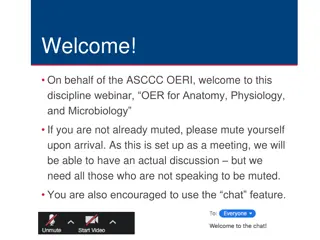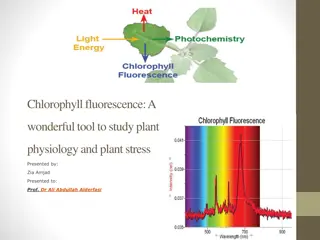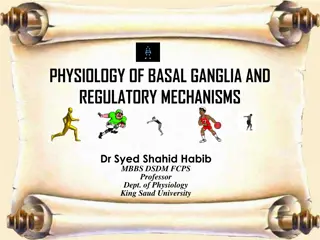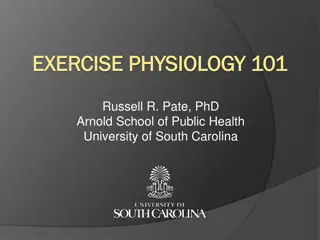Physiology of Pain
The physiology of pain, including its definition, types, causes, nociceptive pathway, transmission, and more. Gain a comprehensive understanding of pain terminology and different phases of nociceptive pain.
13 views • 40 slides
Anatomy and Physiology of the Larynx: Overview and Cartilages
Exploring the anatomy and physiology of the larynx, this content discusses the location, movements, and cartilages of the larynx. Details on the unpaired (thyroid, cricoid, epiglottis) and paired (arytenoid, corniculate, cunieform) cartilages are provided, along with their functions and characterist
9 views • 17 slides
ASCCC OERI Webinar on OER for Anatomy, Physiology, and Microbiology
Welcome to the ASCCC OERI webinar focused on Open Educational Resources (OER) for Anatomy, Physiology, and Microbiology. This event discusses the adoption of OER in California Community Colleges, challenges faced in Anatomy and Physiology, available resources, and potential strategies to increase OE
0 views • 20 slides
Essential Overview of Gastrointestinal Physiology
Exploring the organization and general principles of gastrointestinal physiology, this content covers the anatomical and functional aspects of the GI system, including smooth muscle characteristics, neural control, blood flow, nutrient absorption, waste excretion, and regulatory functions like immun
0 views • 46 slides
Laboratory Safety Rules for Physiology
Ensuring safety in the physiology laboratory is paramount. Adhering to the set rules is crucial to prevent accidents and ensure a productive learning environment. Rules include proper handling of chemicals, wearing appropriate attire, avoiding lab access without supervision, and respecting lab equip
1 views • 14 slides
Understanding Bacterial Physiology and Growth
Bacterial physiology encompasses the growth, nutrition, and metabolism of bacteria. Bacterial growth involves binary fission, generation time, colony formation, and is influenced by various factors such as temperature, atmosphere, moisture, and radiation. Understanding the classification based on te
0 views • 33 slides
Understanding Water Relationships in Plant Physiology
Water plays a crucial role in the physiology of plants, with most absorbed water being translocated to leaves and lost through transpiration and guttation. While essential for turgidity and mineral translocation, plant water use is often inefficient. Transpiration is the primary mode of water loss,
3 views • 22 slides
Understanding Nerves and Muscles Physiology - Lecture Insights
Explore the intricate processes of synaptic transmission, neurotransmitters, spatial summation, temporal summation, chemical substances acting as neurotransmitters, and the effects of various factors and drugs on synapse function. Delve into the clinical significance of sedative-hypnotic drugs and t
0 views • 11 slides
Understanding the Physiology of the Sensory Organ - Tongue by B.K. Singh
Taste perception on the tongue is a vital sensory function involving sweet, sour, salty, and bitter sensations. The tongue, with its muscular movements and taste buds, plays a crucial role in mastication, swallowing, and food enjoyment. Different types of papillae on the tongue are responsible for t
4 views • 33 slides
Understanding Cardiac Electrical Activity in Physiology Team's Cardiovascular Block Lecture
Dive into the intricate details of cardiac electrical activity in this lecture led by Physiology Team 436. Explore topics like the cardiac conductive system, action potentials, refractory periods, excitation-contraction coupling, and the effects of autonomic stimulation on heart electrophysiology. D
0 views • 29 slides
Understanding Microbial Nutrition and Bacterial Physiology
Microbial nutrition involves essential elements required for microbial growth and energy production. Bacterial physiology delves into the structures and functions that enable bacteria to thrive, from cell wall composition to enzyme activities. Major elements like C, O, H, N, S, and P are crucial for
2 views • 20 slides
Understanding Plant Physiology and Water Relations
Plant physiology, specifically water relations, is crucial for the survival and growth of plants. This study delves into the mechanisms of water absorption, cell components like vacuoles and protoplasm, and the concept of water potential. Water plays a vital role in plant functions, from providing m
2 views • 32 slides
Best Lower back pain treatment in Upper Mount Gravatt
Are you looking for the Best Lower back pain treatment in Upper Mount Gravatt? Then contact JY Exercise Physiology. They Specialising in exercise physiology, sport rehabilitation, injury rehabilitation, and powerlifting coaching, they understand that
0 views • 6 slides
High-Altitude Physiology and Its Effects on the Human Body
Understanding the impact of high altitudes on human physiology is crucial for aviation and deep-sea activities. Barometric pressures and alveolar oxygen levels change significantly with altitude, leading to hypoxia-related issues. Factors like carbon dioxide and water vapor further affect alveolar o
1 views • 29 slides
Understanding Physiology: The Science of Living Organisms
Physiology is the study of processes and functions in living organisms, encompassing various disciplines such as physics, chemistry, and mathematics. It delves into the intricate regulation and maintenance of internal environments within our bodies, vital for optimal cell, tissue, and organ function
4 views • 15 slides
Introduction to Plant Physiology: Exploring the Functioning of Plants
Plant physiology is a crucial subdiscipline of botany that delves into the processes and functions operating within plants. This field closely examines areas like plant morphology, ecology, cell biology, and genetics, shedding light on vital processes such as photosynthesis, respiration, and more. T
1 views • 7 slides
Understanding Puberty: Physiology, Changes, and Management
Puberty is a normal physiological process marking the transition from childhood to sexual maturity. Understanding its physiology, factors influencing it, physical changes, stages of development, onset, and precocious puberty is essential for proper diagnosis and management. Various factors like race
1 views • 24 slides
Understanding Esophageal Diseases: Anatomy, Physiology, and Disorders
Explore the anatomy and physiology of the esophagus, learn about common esophageal disorders such as GERD, understand the symptoms, complications, and management of reflux disease, differentiate between oropharyngeal and esophageal dysphagia, and delve into the causes, symptoms, investigations, and
2 views • 16 slides
Understanding Respiratory System Pharmacology and Cough Physiology
The regulation of respiration involves sensory and efferent pathways, with afferent pathways comprising stretch receptors, C-fibres, and irritant receptors, while efferent pathways include parasympathetic and sympathetic nerves. Cough physiology is a protective reflex initiated by various stimuli to
2 views • 43 slides
Understanding the Physiology of Taste in Sensory and Aroma Marketing
Research on the gustatory system has made significant advancements recently, defining taste as a complex mix of olfactory, gustatory, and nervous stimuli. The sense of taste, closely tied to smell, is crucial for perceiving the chemicals in our food. The physiology of taste explores how our tongues
0 views • 14 slides
Understanding Chlorophyll Fluorescence in Plant Physiology
Chlorophyll fluorescence is a powerful tool developed in the 1990s for studying plant physiology and stress. It provides insights into photosynthetic processes at different levels, from subcellular to canopy. By measuring chlorophyll fluorescence, researchers can assess the efficiency of photosynthe
0 views • 16 slides
Exploring the Fascinating World of Biology and Human Biology
Biology is a broad scientific field encompassing the study of living organisms and their various aspects, from anatomy and physiology to genetics and evolution. Branches of biology include anatomy, histology, cytology, physiology, embryology, genetics, molecular biology, biochemistry, zoology, botan
0 views • 21 slides
Exploring Animal Physiology: Functions and Processes
Animal physiology is the study of how animals function and their bodily processes. It delves into feeding mechanisms, digestion in various animals, and the energy requirements that drive their activities. Explore the nutritional requirements of animals, the types of food they need, and the mechanism
0 views • 71 slides
Honors Human Anatomy and Physiology Summer Introduction Packet
Welcome to Honors Human Anatomy and Physiology at Col. Z. Magruder High School! Dr. Newman provides an overview of the course, including anatomical positions, body planes, regional terms, and tables for reference. The packet sets the foundation for studying the structure and function of the human bo
0 views • 7 slides
Overview of Appendicular Skeleton and Bones by Dr. Mahdi H. Hammadi, PhD, Sc. Clinical Physiology
Dr. Mahdi H. Hammadi, PhD, Sc. in Clinical Physiology, provides an insightful look into the bones of the appendicular skeleton, including the shoulder girdle, upper limbs, wrist bones, and hand bones. The text covers the composition and functions of these skeletal elements in a comprehensive manner,
0 views • 21 slides
Understanding Concentration of Solutions in Physiology
Concentration of solutions is crucial in understanding the properties of substances in Physiology. This involves concepts like percentage solutions and molar solutions, where the amount of solute is measured in grams or moles relative to the volume of the solution. Percentage solutions are commonly
0 views • 8 slides
Understanding Water Potential in Plant Physiology
Water potential is a crucial concept in plant physiology, driving the movement of water within plants. It is a measure of potential energy in water and influences processes like photosynthesis. This potential is influenced by factors such as solute concentration, pressure, gravity, and matrix effect
0 views • 25 slides
Insights into Fish Physiology and Thermal Regulation
Exploring the intricate mechanisms of fish physiology, particularly focusing on the autonomic nervous system's role in controlling internal organ functions and maintaining homeostasis. Additionally, delving into how fishes manage thermal regulation and optimize body temperature for growth, feeding,
0 views • 20 slides
Anatomy and Physiology of the Throat: A Comprehensive Overview
The throat, comprising the mouth, pharynx, and associated structures, plays vital roles in digestion, communication, and breathing. Understanding the anatomy and physiology of the throat, from the oral cavity to the laryngopharynx, helps in comprehending functions like swallowing, sound production,
0 views • 15 slides
Understanding Neuromuscular Junction Disorders with Dr. Hana Albulaihe
An in-depth exploration of neuromuscular junction (NMJ) anatomy, physiology, and associated disorders by Dr. Hana Albulaihe, a renowned Consultant Neurologist. The NMJ comprises the axon terminal of a motor neuron and the motor end plate of a muscle fiber. Disorders discussed include Myasthenia grav
0 views • 75 slides
Overview of Zoology: Principals, Objectives, Assessment, and Tips for Success
Delve into the fascinating world of Zoology with a detailed exploration of animal cell structure, tissue types, taxonomy, anatomy, physiology, and more. Learn about assessments, grading criteria, and tips for excelling in lectures. Understand the significance of biology in studying life, including t
0 views • 11 slides
An In-depth Look at the Anatomy and Physiology of the Ear by Dr. Farid Alzhrani
Delve into the comprehensive insights provided by Dr. Farid Alzhrani, Assistant Professor and Consultant of Otolaryngology, Head, and Neck Surgery at King Abdulaziz University Hospital, on the intricate details of the ear's anatomy and physiology. Explore topics such as the external ear structures,
0 views • 41 slides
Understanding the Physiology of Basal Ganglia and Regulatory Mechanisms
This lecture covers the physiology of basal ganglia, including the different nuclei, pathways, and neurotransmitters involved. It explains the functions of caudate and putamen circuits, integration of direct and indirect pathways, and diagnosis of basal ganglia disorders. The connections and basic c
0 views • 24 slides
Understanding Physiology: A Comprehensive Overview and Study Guide
The study of physiology delves into the intricate functions of living systems, encompassing organisms, organs, cells, and bio-molecules. Dr. Ilker Gelisen, a specialist from Wuppertal City Hospital in Germany, provides valuable insights and teachings through a structured program covering various bod
0 views • 19 slides
Understanding the Physiology of Micturition: Bladder Function and Control Mechanisms
Explore the intricacies of micturition physiology focusing on the functional anatomy of the urinary bladder, mechanism of filling and emptying, cystometrogram, and neurogenic control. Delve into the internal structure of the bladder, sphincters, and innervation in males for a comprehensive understan
0 views • 20 slides
Understanding Ear Physiology and Examination Principles
The ear plays a critical role in both hearing and balance. Understanding the physiology of hearing involves 6 basic steps, from sound transfer to neural impulse transmission. When assessing hearing, methods like whispering tests and tuning fork tests can help determine different types of deafness. P
0 views • 18 slides
Pediatric Respiratory Infections: An Overview of Cases and Physiology
This review delves into selected cases of respiratory infections in children presented by Dr. David L. Smith, focusing on the anatomical and physiological aspects of the pediatric airway and respiratory system. It discusses respiratory failure in infants and small children, metabolic demands, cyanos
0 views • 49 slides
Understanding the Significance of Plant Physiology in Agriculture
Plant physiology plays a crucial role in understanding how plants adapt to various environmental conditions, develop mechanisms to cope with stress, and optimize their growth and productivity. This branch of botany explores the structural and functional aspects of plants, delving into cellular, bioc
0 views • 11 slides
Understanding Exercise Physiology Fundamentals
Explore the basics of exercise physiology, including physiologic responses to acute exercise, functional adaptations to chronic exercise, and the mediation of health effects. Learn the difference between physical activity and exercise, the concept of work in exercise, and the energy expenditure invo
0 views • 31 slides
Understanding Cardiac Physiology: Electrical System and Excitation
Explore the intricate details of cardiac physiology, focusing on the electrical conducting system, spread of excitation, ECG interpretation, action potentials, and hemodynamic parameters. Learn about pacemaker cells, differences between ventricular and pacemaker action potentials, and the initiation
0 views • 26 slides







































